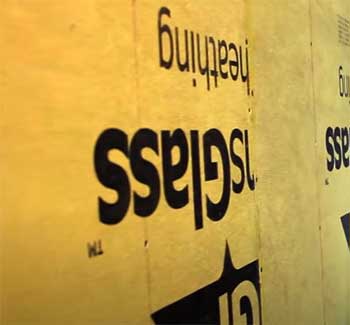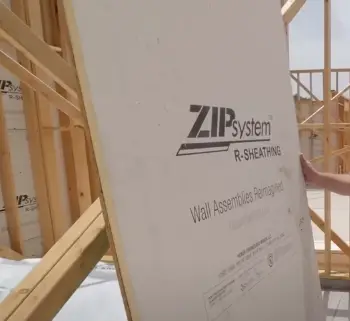When constructing or renovating a home, one of the most important choices is the wall sheathing material. Sheathing provides a protective layer over the wall studs and insulation, while serving as a moisture barrier and providing racking strength to the frame.
Two popular sheathing options for exterior walls are DensGlass and ZIP System. But which one is the better choice for your project?
A Brief Comparison Table
| Feature | DensGlass | ZIP System |
| Material | Fiberglass faced gypsum | OSB or plywood with overlay |
| Water resistance | Excellent, water-resistant mat | Waterproof overlay |
| Vapor permeability | Highly vapor permeable | Semi-vapor permeable |
| Mold resistance | Excellent | Good |
| Fire resistance | 2 hour fire rating | No fire rating |
| Racking strength | Good | Excellent |
| Thermal insulation | R-0.56 | R-1 to R-1.5 |
| Installation | Simple, versatile | Integrated system |
What Is DensGlass?
DensGlass is a fiberglass mat faced gypsum sheathing introduced by Georgia-Pacific in 1984. It consists of a water-resistant and fire-resistant gypsum core faced with a fiberglass mat on both sides.
The main benefits of DensGlass sheathing include:

- Moisture resistance – The fiberglass mat facing provides protection against liquid water penetration. DensGlass scores a 10 for water resistance when tested according to ASTM D3273.
- Mold resistance – The fiberglass mat facing and gypsum core help resist growth of mold and mildew.
- Fire resistance – DensGlass is noncombustible and achieves fire ratings of up to 2 hours when used in tested assemblies.
- Strength – The fiberglass mat reinforces the gypsum core, providing excellent wind load resistance and racking shear strength.
- Thermal performance – DensGlass provides good insulation when compared to OSB, with R-values around R-0.56.
- Versatile installation – Panels can be installed vertically or horizontally using nails, screws, or adhesive. No special tapes or mastics required.
DensGlass is available in a variety of sizes, with thicknesses ranging from 1/4″ to 5/8″. It can be used for exterior walls, interior walls, ceilings, and tile backerboards. While moisture resistant, it is vapor permeable and allows walls to breathe.
What Is ZIP System?
ZIP System is an integrated exterior wall sheathing system introduced by Huber Engineered Woods in 2006. It consists of a plywood or OSB structural panel with a built-in protective overlay and taping system.
The main benefits of ZIP System sheathing include:
- Waterproof barrier – The integrated underlayment provides a water-resistive barrier equivalent to Grade D building paper.
- Air barrier – The overlay and tape system creates an air barrier to reduce drafts.
- Vapor permeable – Allows moisture vapor to diffuse through the panel.
- Racking strength – The engineered wood provides excellent shear strength and wind load resistance.
- Thermal insulation – OSB offers more insulation than DensGlass, with R-values of R-1 to R-1.5.
- Integrated system – Built-in underlayment and tape for quicker, simpler installation.
ZIP System is available as plywood or OSB, in thicknesses from 7/16″ to 1″. Panels are installed horizontally with the built-in overlapped seam sealed with ZIP tape.
Primary Applications
Based on their material properties and performance characteristics, DensGlass and ZIP System tend to be used in the following primary applications:
DensGlass Uses
- Fire-rated exterior walls
- Indoor tile backerboards
- Ceilings and attics
- High humidity areas like bathrooms
- Cost-sensitive projects
ZIP System Uses
- Residential home siding
- Roof sheathing and underlayment
- Unheated buildings like garages and barns
- Cold weather climates
- Projects prioritizing strength
Cost Comparison
One of the biggest differences between DensGlass and ZIP System is cost. Here are some average price estimates:
- 1/2″ 4×8 DensGlass sheet – $15 to $25
- 1/2″ 4×8 ZIP System R sheathing – $35 to $50
So DensGlass typically costs about half as much as ZIP System per sheet. For a 2,000 square foot house, that could mean a $2,000 to $5,000 price difference in materials.
However, there are a few factors that can affect pricing:
- ZIP System OSB is cheaper than ZIP System plywood
- Thicker panels cost more
- Quantity discounts may be available
Labor costs are also a consideration. ZIP System requires fewer steps to install since the underlayment and tape are integrated. But for larger projects, the higher material cost is usually the deciding factor between the two.
Performance Comparison
Let’s take a deeper look at some of the key performance differences:
- Fire Resistance

One of the main benefits of DensGlass is its noncombustible gypsum composition. I
t achieves fire ratings of up to 2 hours for walls when installed per manufacturer specifications.
This makes it a good choice for fire-rated wall assemblies.
ZIP System has no special fire resistant properties.
The wood-based sheathing will burn like regular lumber.
DensGlass is the clear winner when it comes to fire performance.
- Racking Strength
The OSB and plywood core of ZIP System provides superior racking strength and shear wall values compared to DensGlass. OSB resisting racking loads better than gypsum.
For homes in high wind zones or multi-story buildings, ZIP System is likely the better choice to provide structural integrity. DensGlass can still provide adequate strength when installed with closer nail spacing.
- Vapor Permeability
Both products allow for vapor diffusion to let moisture escape, preventing trapped moisture problems. However, DensGlass is highly permeable while ZIP System is only semi-permeable.
In cold climates, the higher permeability of DensGlass may be preferred to allow interior vapor to diffuse through walls more easily. ZIP’s overlay can inhibit vapor diffusion to some degree.
- Mold Resistance
The fiberglass mat facing and gypsum core of DensGlass provides enhanced mold resistance compared to ZIP System. Gypsum boards resist mold growth better than wood-based products.
However, both should perform fine regarding mold inhibition if proper moisture management practices are followed. But DensGlass likely has a slight edge here.
- Installation and Handling
One advantage of ZIP System is the integrated installation process – just taking sheathing from the stack to the wall. With DensGlass, good craftsmanship is needed to properly tape seams, transitions, and fastener heads.
ZIP System OSB is also lighter and easier to handle than DensGlass panels. So ZIP System can make the installation process simpler and quicker in many cases.
Best Practices for Installation
To get the best performance from either system, following good installation practices is key:
DensGlass Installation Tips
- Use galvanized or stainless steel fasteners
- Seal all exposed board edges and fastener heads with mesh tape and setting compound
- Install with 1/8″ gap between board edges
- Stack flat, keep dry before installation
- Cut outdoors or with dust collection methods
ZIP System Installation Tips
- Install colored side facing out
- Lap upper panels over lower panels
- Use ZIP tape for all seams and laps
- Follow specified fastener spacing and edge distances
- Install per APA and manufacturer instructions
Proper installation for either system is important to achieve proper moisture control, air sealing, and shear strength.
Which Is Better?
So when considering DensGlass vs ZIP System, which exterior sheathing is the right choice?
Here are some quick recommendations:
- For fire-rated wall assemblies, go with DensGlass
- For super moisture-resistant barrier, choose ZIP System
- If mold resistance is critical, lean towards DensGlass
- For superior strength, use ZIP System
- To minimize material costs, DensGlass is the most economical
- For simpler installation, ZIP System’s integrated system is preferable
Frequently Asked Questions (FAQ)
There are a few exterior sheathing alternatives that can outperform ZIP System in certain areas:
DensGlass – More fire resistant, economical, and mold/mildew resistant than ZIP System. But lower racking strength.
Plywood – Cheaper than ZIP System and excellent racking strength. But doesn’t have integrated moisture barrier. Requires building wrap or tar paper.
Rigid foam insulation – Provides higher R-value insulation. Must be used with separate sheathing.
Liquid-applied membranes – Achieve ultimate waterproofing when applied properly. Requires skill to install.
ZIP System’s integrated sheathing and tape provide a more complete air and moisture barrier versus using a separate product like Tyvek. Benefits of ZIP System over Tyvek:
1. Fewer seams/gaps than wrapping alone
2. Underlayment overlapped shingle-style for water management
3. Tightly sealed with ZIP tape at lap joints
4. No need for additional fasteners through housewrap
5. Acts as a water-resistive barrier and air barrier
However, the main advantage of Tyvek is cost savings over ZIP System. For optimal energy efficiency and weather resistance, the integrated ZIP System performs better. But Tyvek is a more budget-friendly option.
ZIP System typically costs 50-100% more than basic OSB sheathing. The extra cost may be worth it for:
1. Faster, simpler installation with built-in barrier
2. Superior wind and shear strength over housewrap alone
3. Enhanced weather and air sealing for efficiency
4. May allow thinner wall assemblies for more interior space
The higher material cost can often be offset by labor savings in not dealing with separate building wraps. ZIP System’s engineered performance and warranty may justify the investment for many builders and homeowners. But for budget-conscious projects, cheaper alternatives like Tyvek remain viable options.
DensGlass’ unique properties make it well-suited for the following applications:
1. Exterior sheathing in fire-rated wall assemblies (esp. commercial)
2. Tile backerboard for wet areas like bathrooms
3. Sheathing material for improves sound transmission loss
4. Attic and ceiling boards to resist moisture and mold growth
5. Areas where mold resistance is especially important
6. Cost-effective sheathing choice for residential construction
7. Compliment to rigid foam to improve shear strength
DensGlass’ combination of moisture resistance, fire performance, and economics make it a versatile choice for a variety of construction projects. Its effectiveness as an exterior sheathing alternative to plywood or OSB contributes to its popularity.
Final Thoughts
There are great arguments for both products. In many cases, either DensGlass or ZIP System would perform well and achieve code compliance. Choosing between the two comes down to the specific project requirements and budget.
Talk with your architect or contractor about the benefits of each to determine the best option for your particular walls. And be sure to follow the manufacturer’s instructions during installation.
